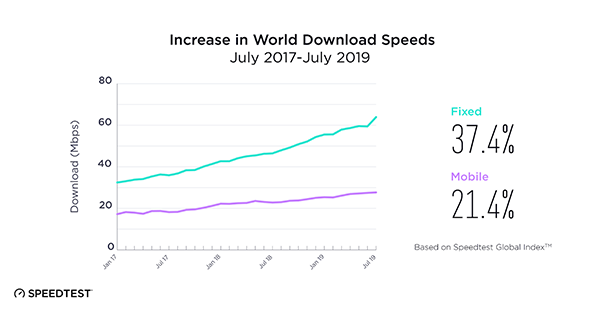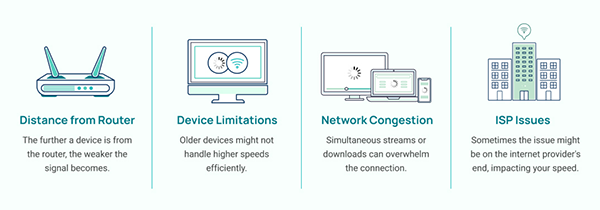Ever felt like your internet is slower than a snail? Well, you’re not alone my friend, as there are countless users around the globe, who go through the same frustration every day.
However, the global internet connection rate is constantly growing with some great potential. For instance, according to the Ookla estimation, the average network speed has risen by 31.9%, and it is since 2017.
But before you start blaming your internet service provider for some slow connection, it’s crucial to understand how the network speed actually works, and what factors can contribute to its result.
So, in this read, I will help you dive into the intricacies of internet speed. And, equip you with enough knowledge to make an informed decision about your connection.
Let’s start!
To properly understand internet speed tests, it’s essential to grasp what they measure: latency, download and upload speed. The download speed indicates how quickly data is transferred from the wireless network to your device, while the upload one reflects how fast your device sends data to the network. Latency, often measured in milliseconds (ms), indicates the delay in data transfer. High latency can affect real-time activities like gaming and video conferencing.
You can use online tools to check if you have a reliable connection. For instance, you can check Reno’s broadband quality through various testing tools available online, allowing you to gauge whether your internet connection meets your needs for daily activities. This will enable you to make informed decisions about your broadband service and understand how different speeds can impact your online experience.

Not all speed test tools provide the same accuracy or reliability. Various online platforms can yield different results due to factors such as server locations and congestion. When selecting a tool, look for one that offers consistent measurements and a straightforward user interface.
Testing your connections at different times of the day can give you a clearer picture of your internet performance. Be sure to close unnecessary applications and devices connected to your network during the test for more accurate readings, as they can interfere with the measurements and provide misleading data.
The ISPs typically advertise speeds that represent the maximum potential of their service, which might not reflect actual performance. These advertised connectivity rates are often based on ideal conditions, such as when a few users are online or during off-peak hours. Understanding this discrepancy is crucial.
When conducting the tests, you might notice that your actual performance levels are lower than what was promised. Factors such as network congestion, physical distance from the router, and even your device’s capabilities can influence these results. Therefore, knowing how to interpret the differences between advertised and actual rates can help set realistic expectations.

Several factors can impact the outcome of your internet speed tests, making it crucial to consider these variables for accurate readings. The type of connection (fibre, cable, DSL) plays a significant role in the overall performance, as fibre tends to offer the fastest connection.
Additionally, the distance from your router, the number of connected devices, and even network interference from walls or other electronics can affect results. Testing on a wired connection usually yields more reliable data compared to wireless. Understanding these elements can help identify potential issues with your connection and inform you about necessary adjustments for better performance.
Do You Know?
According to the Speedtest Global Index, the global average download speed in February 2023 was around 94.16 Mbps, with Singapore having the fastest internet speed of around 305.01 Mbps.
Internet speed can fluctuate throughout the day due to peak usage times when many people are online simultaneously. To get a complete picture of your connection’s performance, it’s wise to conduct connection tests during various times—morning, afternoon, evening, and late at night.
These tests can reveal patterns in your network connectivity, such as slower speeds during busy hours or reliable connectivity when there are off-peak times. By analyzing these results, you can better understand how your ISP’s network congestion affects your browsing experience, streaming, or online gaming. This knowledge can also help you determine the best time for activities that require high bandwidth.

After conducting speed tests and analyzing your results, it’s essential to know how to take appropriate action. If your internet connections are consistently lower than what you’re paying for, consider contacting your ISP for support or troubleshooting. Sometimes, resetting your router or modem can resolve connectivity issues.
Making the most of your home network by relocating the router to a central location or upgradingyour hardware may improve performance. If problems persist, consider exploring other service plans or ISPs that better meet your needs. Taking these steps can help ensure you receive the internet performance necessary for your activities, whether for work, education, or entertainment.
The Internet is an ever-evolving landscape, and it is only by equipping yourself with enough knowledge, that you can easily navigate the digital world with confidence. This will help you ensure that your online activities are as fast and efficient as possible.
So, remember you’re not just a passive user of the internet, but an active participant, who is well-informed to optimize your home network for a smooth browsing experience.
